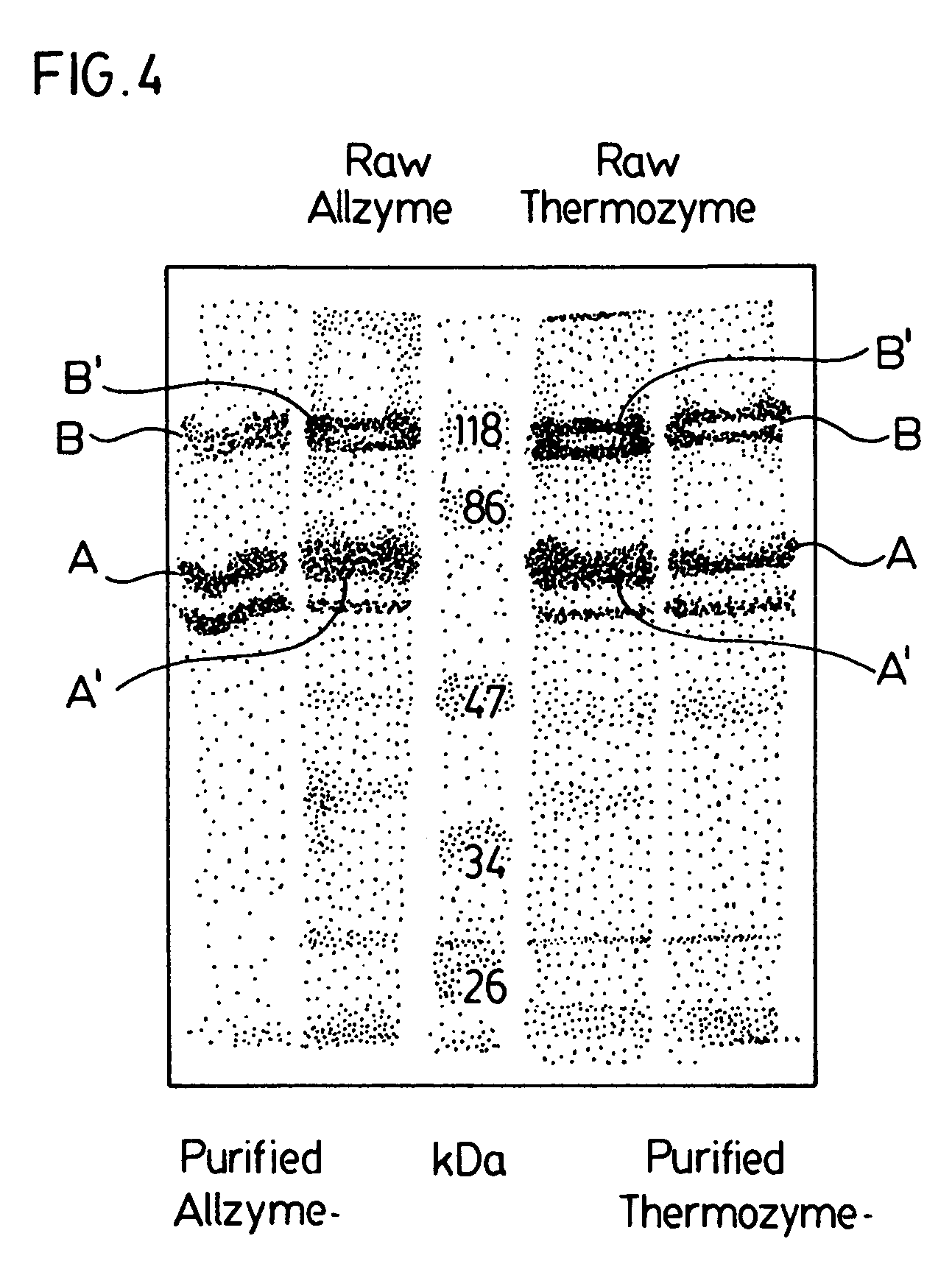Method of enhancing enzyme activity and enzyme solution having enhanced activity
a technology of enzyme activity and enzyme solution, which is applied in the field of enzymes, can solve the problems of limiting the economic feasibility of enzyme-mediated processes and limited industrial use of enzymes, and achieve enhanced activity, enhanced activity, and the effect of preserving the original level of enzymatic activity
- Summary
- Abstract
- Description
- Claims
- Application Information
AI Technical Summary
Benefits of technology
Problems solved by technology
Method used
Image
Examples
example 1
Purification of Alpha Amylase with Activated Carbon
[0033]A purified enzyme solution was prepared as shown generally as 10 in FIG. 1.
[0034]A diluted raw enzyme solution (12), comprising 60 mL raw amylase (Allzyme®, amylase from Alltech) and 270 mL of 0.05M phosphate buffer (pH 6), was prepared and mixed with 24 g of activated carbon (14) for 3 h with magnetic stirring at 300 rpm in a vessel (16). The purified enzyme (18) was separated from the activated carbon (20) by filtration. Assays of the raw enzyme solution, before dilution (12) and the purified enzyme solution (18) were conducted. The activity of the amylase solution (19) before dilution to produce solution (12) was 2035 U / mL, whereas the activity of the purified enzyme (18) was 2010 U / mL, notwithstanding that, due to dilution, the purified preparation contained only about 18 mL of amylase per 100 mL of solution (18). Thus, the activity of the purified enzyme (18), expressed per mL of raw amylase, would be about 11000 U / mL, or...
example 2
Purification of Alpha Amylase with Activated Carbon
[0035]An alternative purified enzyme solution (18) was prepared according to FIG. 1 wherein a diluted raw enzyme solution (12), comprising 40 mL raw amylase (Spezyme® Fred amylase, from Genencor) and 360 mL of water was prepared and mixed with 8 g of activated carbon (14) for 12 h with magnetic stirring at 250 rpm in vessel (16). The purified enzyme (18) was separated from the activated carbon (20) by filtration. Assays of the raw enzyme solution before dilution (19) and the purified enzyme solution (18) were conducted. The activity of the amylase solution before dilution (19) was 4486 U / mL, whereas the activity of the purified enzyme (18) was 4170 U / mL, notwithstanding that, due to dilution, the purified formulation (18) contained only about 10 mL of raw amylase per 100 mL of solution. Thus, the activity of the purified enzyme (18), expressed per mL of raw amylase, would be about 41700 U / mL, or about 9.3 times the activity of the o...
example 3
Purification of Glucoamylase
[0036]5 mL of glucoamylase (Genencor) was blended with 45 mL of 0.05M citrate buffer (pH 4.0), added to 2 g of activated carbon and mixed for 12 h at 250 rpm. The purified enzyme was separated from the activated carbon by filtration. Assays of the raw enzyme solution before dilution (19) and the purified enzyme solution (18) were conducted. The activity of the raw enzyme solution was 980 U / mL, and the activity of the purified enzyme solution was 350 U / mL, notwithstanding that, due to dilution, the purified formulation (18) contained only about 5 mL of raw amylase per 50 mL of solution. Thus, the activity of the purified enzyme (18), expressed per mL of raw amylase, would be about 3500 U / mL, or about 3.6 times the activity of the original amylase formulation (19).
[0037]The aforesaid examples show that purification of these two commercial amylase formulations with activated carbon has led to a clear improvement in activity. As hereinbefore mentioned, this i...
PUM
| Property | Measurement | Unit |
|---|---|---|
| Fraction | aaaaa | aaaaa |
| Nanoscale particle size | aaaaa | aaaaa |
| Nanoscale particle size | aaaaa | aaaaa |
Abstract
Description
Claims
Application Information
 Login to View More
Login to View More - R&D
- Intellectual Property
- Life Sciences
- Materials
- Tech Scout
- Unparalleled Data Quality
- Higher Quality Content
- 60% Fewer Hallucinations
Browse by: Latest US Patents, China's latest patents, Technical Efficacy Thesaurus, Application Domain, Technology Topic, Popular Technical Reports.
© 2025 PatSnap. All rights reserved.Legal|Privacy policy|Modern Slavery Act Transparency Statement|Sitemap|About US| Contact US: help@patsnap.com



